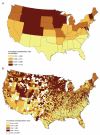Kidney transplantation and the intensity of poverty in the contiguous United States
- PMID: 24809750
- PMCID: PMC4182918
- DOI: 10.1097/TP.0000000000000125
Kidney transplantation and the intensity of poverty in the contiguous United States
Abstract
Background: Geographic variation in kidney transplantation rates in the United States has been described previously but remains unexplained by age, race, sex, or socioeconomic status differences. Geographic variations in the concentration of poverty appear to impact end-stage renal disease care and potentially access to transplantation.
Methods: We studied the impact of how spatial topography of poverty across geographical regions in the contiguous United States is associated with kidney transplantation in the 48 contiguous U.S. states.
Results: We found considerable geographic variation in transplantation rates across the country that persisted across quartiles of county-level median household income and percentage minority population. Higher transplant rates were seen with increasing median household income and decreasing minority populations but were not influenced by education level. Transplantation rates in counties with poverty rates above the national average had low transplant rates, but these rates were influenced by the poverty level in the surrounding counties. Similarly, wealthy counties had higher transplant rates but were lowered in counties of relative wealth that were surrounded by less wealthy counties.
Conclusions: Our results underline the geographical heterogeneity of kidney transplantation in the United States and identify regions of the country most likely to benefit from interventions that may reduce disparities in transplantation.
Figures





References
-
- Saunders MR, Cagney KA, Ross LF, et al. Neighborhood poverty, racial composition and renal transplant waitlist. Am J Transplant. 2010;10:1912. - PubMed
-
- Tonelli M, Klarenbach S, Rose C, et al. Access to kidney transplantation among remote- and rural-dwelling patients with kidney failure in the United States. JAMA. 2009;301:1681. - PubMed
-
- Ashby VB, Kalbfleisch JD, Wolfe RA, et al. Geographic variability in access to primary kidney transplantation in the United States, 1996–2005. Am J Transplant. 2007;7(5 Pt 2):1412. - PubMed
Publication types
MeSH terms
Grants and funding
LinkOut - more resources
Full Text Sources
Other Literature Sources
Medical

